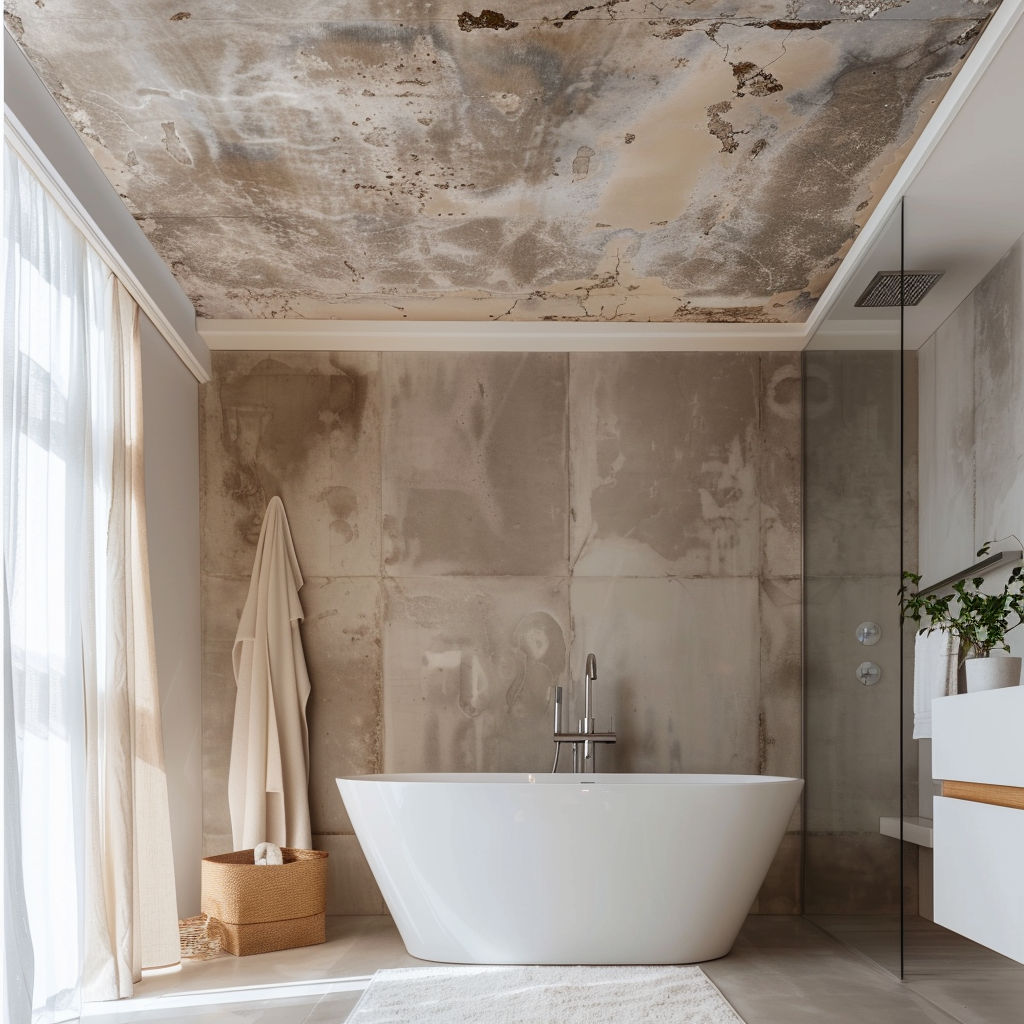In the warm, humid embrace of South Florida, homeowners often face a hidden adversary lurking in their bathrooms: black mold. This unwelcome guest finds sanctuary on ceilings where warmth and moisture meet, posing not just an aesthetic issue but potential health risks as well. Through this exploration, we aim to unravel the mysteries of black mold—shedding light on its dangers and guiding you through effective strategies for prevention and removal.
What is Black Mold?
Definition and Characteristics
Stachybotrys chartarum, commonly known as black mold, thrives in damp, warm environments often resulting from excessive indoor humidity or water damage. Characterized by its dark coloration—ranging from deep green to black—and slimy texture, this mold variety releases spores that can be harmful when inhaled.
Black mold distinguishes itself not just through appearance but also by the musty odor it emits, making it detectable even before visible signs appear. Understanding these characteristics is crucial for homeowners to identify potential infestations early and take prompt action.
Causes of Black Mold Growth on Bathroom Ceilings
High Humidity Levels
In regions like South Florida, the naturally high humidity provides an ideal breeding ground for mold spores. Bathrooms, in particular, experience elevated moisture levels due to steam from showers and baths—making ceilings a common site for black mold colonization.
Lack of Proper Ventilation
Insufficient ventilation exacerbates the problem by trapping moist air inside the bathroom. Without adequate airflow to dry out damp surfaces, condensation accumulates on walls and ceilings, offering mold spores the perfect conditions to grow and spread.
Understanding these primary causes helps homeowners recognize risk factors within their bathrooms. Addressing these issues is fundamental in preventing black mold’s appearance and ensuring a healthier living environment.
Health Risks Associated with Black Mold Exposure
Respiratory Issues
Inhaling spores from black mold can lead to a variety of respiratory problems. Individuals may experience symptoms ranging from coughing and wheezing to more severe reactions like asthma attacks or chronic sinus infections. Those with pre-existing respiratory conditions are particularly at risk for aggravated symptoms.
Allergic Reactions
Black mold exposure can also trigger allergic responses in sensitive individuals. Symptoms such as sneezing, itching eyes, skin rashes, and runny nose are common indicators of an allergic reaction to mold spores. Over time, continuous exposure may heighten sensitivity leading to more pronounced allergic reactions.
Potential Long-term Health Effects
Prolonged exposure to black mold has been linked with more serious health concerns beyond immediate allergic and respiratory issues. Though research is ongoing regarding the full extent of long-term effects, there is evidence suggesting potential implications for immune system suppression and neurological problems in some cases.
Understanding these health risks underscores the importance of promptly addressing black mold infestations—not only to protect your home’s structural integrity but also the well-being of its occupants.
Identifying Black Mold vs. Other Types of Mold or Mildew
Visual Differences
Black mold, with its distinctive dark color and slimy texture, can sometimes be confused with other types of mold or mildew that also occur in damp areas of the home. While black mold tends to grow in large colonies, other molds might appear lighter in color—ranging from green to white—and have a powdery texture. Recognizing these visual cues helps homeowners identify what they are dealing with.
Symptoms Indicating the Presence of Black Mold
Apart from visible signs, certain symptoms can suggest an infestation even before it becomes apparent. A persistent musty odor is often a telltale sign of hidden mold growth within walls or ceilings. Additionally, unexplained health issues such as worsening allergies or respiratory problems when indoors may indicate the presence of black mold spores in your environment.
Distinguishing between black mold and other fungi is crucial for determining the appropriate removal strategy and preventing potential health risks associated with each type’s exposure.
How to Safely Address Minor Black Mold Infestations
DIY Cleaning Tips for Small Areas
For minor infestations confined to a small area, homeowners can attempt mold removal using household products. A solution of water and detergent or a mixture of vinegar and water applied with a sponge or brush can be effective for non-porous surfaces. It’s essential to wear protective gloves and a mask during the process to avoid direct exposure to mold spores.
When to Call Professionals for Removal
If the affected area is larger than ten square feet, or if mold recurs despite thorough cleaning, it’s time to seek professional help. Specialists in mold remediation have the necessary equipment and expertise to safely remove extensive growths without risking further spread throughout your home. Additionally, they can identify underlying moisture issues contributing to mold problems ensuring long-term resolution not just temporary relief.
Tackling black mold promptly minimizes health risks and ensures your bathroom remains a safe comfortable space within the home. Knowing when you handle the situation yourself versus calling experts is key to effectively managing potential dangers posed by this unwelcome guest.


